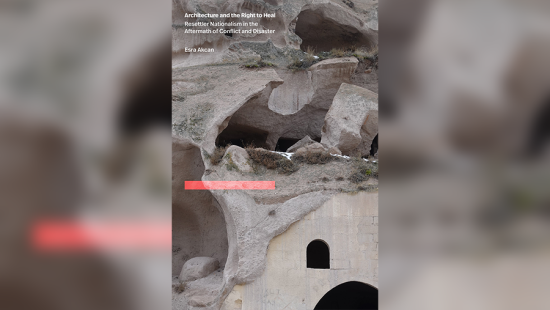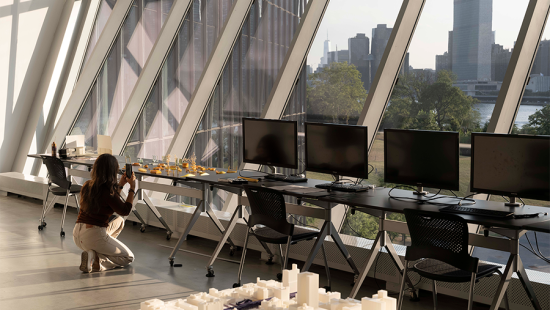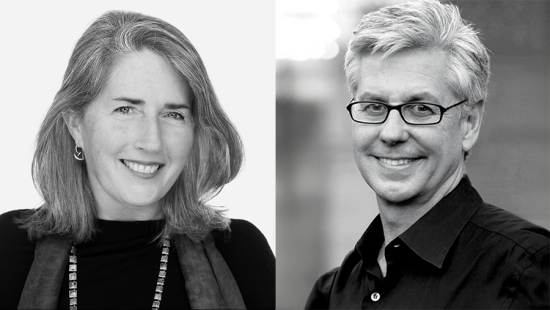Announcing: Women, Art, Freedom: Artists and Street Politics in Iran by Pamela Karimi
Across a series of ten "acts," Karimi's new book investigates the art and activism in Iran that have played a crucial role in the Woman, Life, Freedom uprising.

Jina Mahsa Amini's detention for "improper" clothing and her subsequent death in police custody fueled the widespread Women, Life, Freedom movement in Iran sparked in 2022, including public actions taken by the country's community of artists. In her just-published book Women, Art, Freedom: Artists and Street Politics in Iran (Leuven University Press, September 2024), Architecture Associate Professor Pamela Karimi explores the wave of artistic activism that accompanied the outcry and the impact of this protest work.
Molly Sheridan: Would you share a bit about the culture of the creative community in Iran and how that made such a powerful response during the fall 2022 Woman, Life, Freedom uprising in the country possible?
Pamela Karimi: During the 2022–23 uprising in Iran, a powerful wave of artistic activism swept through public spaces, universities, and art institutions. Both emerging and established artists risked their safety to participate in acts of creative resistance, but this movement was not spontaneous — it was built on years of quiet rebellion and artistic expression. Iran's art scene has long been a catalyst for change, with artists engaging in street performances well before the recent protests. A striking example occurred in 2011, when women dressed in bold red took over a busy intersection in Tehran. This performance paid tribute to a woman who, before the 1979 Islamic revolution, stood at that same spot in full red attire, expressing her love and longing for a man she was waiting for. This was a bold act, especially considering that women in the Islamic Republic are prohibited from publicly expressing their love and passion. A wide array of these artworks is documented in my book Alternative Iran: Contemporary Art and Critical Spatial Practice, which was published in the fall of 2022, coinciding with the start of the uprising.

Mohammad Hosseini et al., Women in Red (2011), Ferdowsi Square, Tehran. image / Saeed Kiaee, courtesy of the artist
Amidst the uprising, artistic expression took on a central role, particularly among women and youth, who used their work to amplify the voices of those on the frontlines. Despite restrictions, like the mandatory hijab law and increased surveillance, artists reclaimed public spaces through creative acts, showing solidarity and resistance.
In my recently published book Women, Art, Freedom, I explore how artists used their craft to challenge the regime. For example, one woman artist used her body by literally rolling through the streets of Mashhad to reclaim public space, while another artist organized passersby to untangle ropes, symbolizing community conflict resolution. A favorite project of mine is by dancer and filmmaker Tanin Torabi, whose performances in public spaces reenacted protest gestures, challenging authority and turning the streets into spaces of defiance. Another is a group of political poets merging poetry with performance art, blending traditions like public recitations of Iran's legendary 11th-century Book of Kings with modern practices of poetry jamming. This vibrant movement highlights the deep creative spirit of Iran's artistic community in times of resistance.

Tanin Torabi et al., still from Until… (2023), Tehran. This film, based on a real-time performance on the streets of Tehran during the peak of the uprising, "reenacts" acts of protest. image / courtesy of Tanin Torabi and photographer Arya Khaksari
However, the creative involvement of artists went far beyond guerrilla interventions. As the peak of the uprising passed, more artists began reflecting on the politics of space and the treatment of women in public spaces through monumental works. One particularly notable installation, set in a gallery garden open to the public, exemplifies this shift. A collaboration between a filmmaker, an architect, and other art experts, the large-scale installation (which is also featured in this book) commemorates the uprising and the suffering of women. These long-term installations require permission from the Ministry of Culture and Islamic Guidance, an organization that functions similarly to the "morality police," which controls women's appearance and behavior in public spaces. To secure approval, artists must be exceptionally clever, presenting their work in abstract terms to avoid rejection.
In this specific kinetic installation, the silent expressions of actress Pantea Mahdinia — conveying sadness, disappointment, horror, and intimidation — respond to the off-screen performative interrogations of filmmaker Mohammad Parvizi. Architect Mahsa Masoudi ensured that the installation highlighted Tehran's spatial politics. As viewers navigate the prison-like scaffolding surrounding the larger-than-life face of the actress, they experience a compelling urge to both empathize with the woman on screen and break free from the confinement of the space. This immersive experience encourages viewers to actively engage in critical spatial practice, a rehearsal for real-life situations.
What I truly admire about Iran's creative community is their ability, honed over years of trial and error, to convey powerful messages while avoiding severe consequences. This covert language, however, is understood by the general public, who have become adept at reading between the lines.

Mohammad Parvizi et al, Call Me by My Name (December 2023–April 2024), Risheh 29 Gallery, Tehran. image / Vida Mousavian, courtesy of Mohammad Parvizi and the Deyhim Foundation
MS: As a historian of art and architecture, what attracted you to diving so deeply into this intersection between art and street politics and authoring this book? What lessons or insights did you gain from the artists you spoke with during your research?
PK: As an architect, I've always been intrigued by how people engage with public space. In my book, I explore how Iranian artists transformed streets and urban environments into stages for activism, where protests often became performative acts that merged with city life. Drawing on Asef Bayat's concept of street politics and Michel de Certeau's "tactical interventions," I examine how marginalized groups use public spaces for political dissent and communal expression. These artistic interventions — ranging from mobile installations to performance art — not only challenge the state's control of public spaces but also shape the conversation and politics surrounding them.
MS: What do you most hope readers of the book take away?
PK: I want my readers to come away with a deep appreciation for the immense effort required to make a feminist movement possible. Protests can appear chaotic from the outside, particularly when seen through the lens of social media or mainstream news. My book reveals the careful planning and years of critical spatial practice behind what often seems like spontaneous acts of defiance. Iranian artists, in particular, are not simply reacting impulsively — they tactically confront power structures, drawing from a rich history of political and artistic activism. In short, the art emerging from the Women, Life, Freedom uprising movement exemplifies the sophistication of Iran's peaceful pursuit of democracy.







